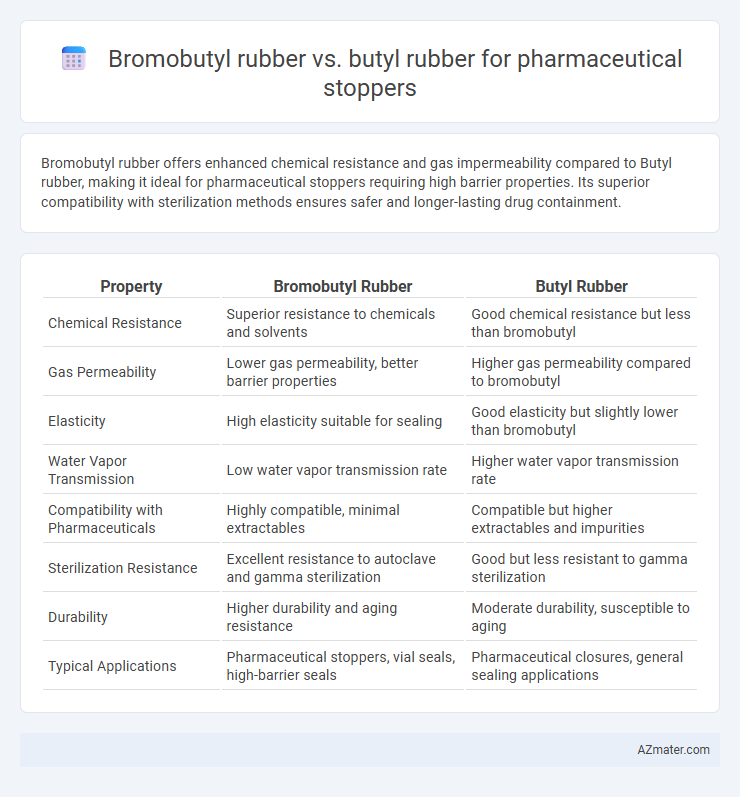Bromobutyl rubber offers enhanced chemical resistance and gas impermeability compared to Butyl rubber, making it ideal for pharmaceutical stoppers requiring high barrier properties. Its superior compatibility with sterilization methods ensures safer and longer-lasting drug containment.
Table of Comparison
| Property | Bromobutyl Rubber | Butyl Rubber |
|---|---|---|
| Chemical Resistance | Superior resistance to chemicals and solvents | Good chemical resistance but less than bromobutyl |
| Gas Permeability | Lower gas permeability, better barrier properties | Higher gas permeability compared to bromobutyl |
| Elasticity | High elasticity suitable for sealing | Good elasticity but slightly lower than bromobutyl |
| Water Vapor Transmission | Low water vapor transmission rate | Higher water vapor transmission rate |
| Compatibility with Pharmaceuticals | Highly compatible, minimal extractables | Compatible but higher extractables and impurities |
| Sterilization Resistance | Excellent resistance to autoclave and gamma sterilization | Good but less resistant to gamma sterilization |
| Durability | Higher durability and aging resistance | Moderate durability, susceptible to aging |
| Typical Applications | Pharmaceutical stoppers, vial seals, high-barrier seals | Pharmaceutical closures, general sealing applications |
Introduction to Pharmaceutical Stoppers
Pharmaceutical stoppers require superior gas and moisture barrier properties to ensure drug stability and sterility, making bromobutyl rubber a preferred material due to its enhanced chemical resistance and lower permeability compared to traditional butyl rubber. Bromobutyl rubber's improved elastomeric performance under sterilization processes results in reduced risk of stopper coring and particulate contamination. The selection of bromobutyl over butyl rubber in pharmaceutical stoppers directly supports compliance with stringent regulatory standards such as USP <381> and ISO 8871-3.
Overview of Butyl Rubber
Butyl rubber is a synthetic elastomer widely used in pharmaceutical stoppers due to its excellent impermeability to gases and resistance to chemical degradation, ensuring the integrity and sterility of the drug container. It exhibits superior air and moisture barrier properties compared to natural rubber, making it ideal for maintaining the stability of injectable and biologic products. Bromobutyl rubber, a halogenated derivative of butyl rubber, offers enhanced compatibility with sterilization processes while retaining the excellent sealing performance required in pharmaceutical packaging.
Overview of Bromobutyl Rubber
Bromobutyl rubber is a halogenated derivative of butyl rubber known for its exceptional impermeability to gases and excellent chemical resistance, making it highly suitable for pharmaceutical stoppers. Compared to butyl rubber, bromobutyl offers superior compatibility with sterilization processes such as autoclaving and gamma radiation, ensuring integrity and safety in pharmaceutical packaging. Its enhanced sealability and low extractables profile contribute to maintaining drug stability and preventing contamination in parenteral applications.
Key Differences Between Bromobutyl and Butyl Rubber
Bromobutyl rubber offers superior chemical resistance and enhanced impermeability compared to butyl rubber, making it ideal for pharmaceutical stoppers requiring low gas permeability and strong barrier properties. Butyl rubber exhibits excellent elasticity and moisture resistance but lacks the halogen substitution that improves the overall chemical stability found in bromobutyl variants. The presence of bromine in bromobutyl rubber also contributes to better compatibility with sterilization processes and extended shelf life in pharmaceutical packaging applications.
Gas and Moisture Barrier Properties
Bromobutyl rubber exhibits superior gas and moisture barrier properties compared to traditional butyl rubber, making it highly suitable for pharmaceutical stoppers that require enhanced protection against oxygen and water vapor ingress. The halogenation in bromobutyl rubber increases its impermeability, reducing the risk of contamination and maintaining the sterility and efficacy of pharmaceutical products. This improved barrier function ensures longer shelf life and better preservation of sensitive medications.
Chemical Resistance and Extractables
Bromobutyl rubber exhibits superior chemical resistance compared to standard butyl rubber, making it more suitable for pharmaceutical stoppers exposed to aggressive drug formulations and solvents. It also demonstrates lower extractable levels, minimizing the risk of contamination and ensuring product integrity in injectable and parenteral applications. The enhanced barrier properties of bromobutyl rubber contribute to improved shelf-life stability by reducing permeability to gases and moisture.
Compatibility with Pharmaceutical Products
Bromobutyl rubber offers superior compatibility with pharmaceutical products due to its enhanced chemical resistance and lower permeability to gases compared to traditional butyl rubber. The presence of bromine in bromobutyl rubber improves its resistance to sterilization processes, making it ideal for injectable drug packaging and maintaining drug stability. Butyl rubber, while also providing good impermeability, is more prone to extractables, which can compromise sensitive pharmaceuticals over time.
Performance in Sterilization Processes
Bromobutyl rubber exhibits superior resistance to high-temperature steam sterilization and radiation methods compared to butyl rubber, maintaining its mechanical integrity and chemical stability during autoclave and gamma irradiation processes. Its enhanced impermeability and reduced extractables make it more suitable for pharmaceutical stoppers requiring stringent aseptic conditions and regulatory compliance. Butyl rubber, while offering good general barrier properties, tends to degrade faster under prolonged sterilization cycles, leading to potential contamination risks and reduced shelf life.
Cost and Production Considerations
Bromobutyl rubber offers enhanced chemical resistance and lower gas permeability compared to butyl rubber, making it ideal for pharmaceutical stoppers requiring extended shelf life. Production costs for bromobutyl are generally higher due to more complex synthesis and raw material expenses, impacting overall manufacturing budgets. Butyl rubber remains cost-effective with simpler processing and shorter curing times, suitable for high-volume stopper production with less stringent barrier properties.
Choosing the Right Rubber for Pharmaceutical Stoppers
Bromobutyl rubber offers enhanced chemical resistance and lower permeability compared to standard butyl rubber, making it ideal for pharmaceutical stoppers requiring superior drug compatibility and extended shelf life. Butyl rubber provides excellent gas impermeability and flexibility but may exhibit slightly higher extractables, which could impact sensitive formulations. Selecting bromobutyl rubber for stoppers ensures optimal barrier properties and reduced contamination risk in injectable drug packaging.

Infographic: Bromobutyl rubber vs Butyl rubber for Pharmaceutical stopper
 azmater.com
azmater.com